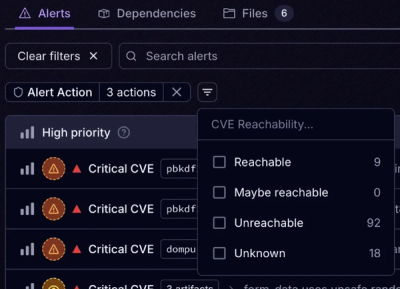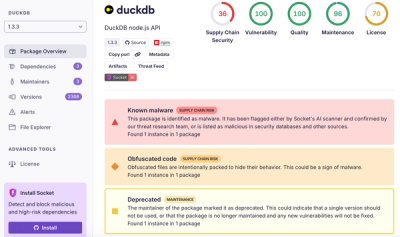
Product
Introducing Tier 1 Reachability: Precision CVE Triage for Enterprise Teams
Socket’s new Tier 1 Reachability filters out up to 80% of irrelevant CVEs, so security teams can focus on the vulnerabilities that matter.
The react-jsx module allows you to compile your JSX (.jsx) templates to:
React.createElement DOM syntax (default for server and client).These templates can be used on the server and client. This way you can move
your JSX templates out of your React.createClass's render method and to
it's own template files which leads to a more manageable code base.
In addition to the features mentioned above we also eliminated the requirement
of "global" and "locally" scoped variables in your template. You can now pass in
the data using a data argument.
By using the same templates on the front and back-end you can create progressively enhanced and SEO friendly web pages.
The module is published in the public npm registry and can be installed using:
npm install --save react-jsx
And that's it! To learn more about how the API works, continue to the [usage] section.
The minor version of this module is in sync with the version of react and
react-tools that we depend upon. Bug fixes to this library will be done as
patch releases so you should read our versioning as:
<react.major.version>.<react.minor.version>.<our.react-jsx-module.patches>
The earliest version of react that we support is 0.12. So please note that our 0.0.x releases CAN include a breaking change so when you're adding this module to your package.json make sure you put down the full semver version.
In all of the examples we assume that you've already required the jsx compiler
as following:
'use strict';
var jsx = require('react-jsx');
This jsx variable now contains 3 methods:
jsx templates for
server-side usage. We will automatically inject React as global in the
templates so it all works as intended. We will return a function which you can
call to render your template.jsx templates for
client-side usage. It assumes that React is already available as global on the
page. We will return a function which you can call to render you template.Both the server and client method share the same API for compiling and rendering:
var template = fs.readFileSync('template.jsx', 'utf-8');
var server = jsx.server(template, { /* options */});
var client = jsx.client(template, {});
console.log(server({ data: 'for template' }));
And they also share the same options:
debug to true.true, we will automatically inline source map.es3 for the client and es5 on the server.data-react-xxx
attributes. Setting this option to true will return a clean HTML instead.When rendering the templates both the server and client method will return the
expected React.createElement nodes just like you would normally do in your
templates so you can easily share templates with child/parent relations. If you
want the template methods. But your might want to output the raw/pure HTML
instead. This can be done by supplying { html: true } as option to the
template function:
var template = fs.readFileSync('/path/to/template.jsx', 'utf-8')
, render = jsx.server(template, { filename: 'template.jsx' });
console.log(render({ foo: 'bar' }, { html: true }));
The generated client and server functions accept data or "scope" for the templates as first argument:
render({ foo: 'bar' });
If you want to set a custom this context for the template you could call the
returned template function as followed:
render.call({ custom: 'this', value: 'is possible' });
But the template function we've generated is smart enough to figure out if
you're passing around React instances and will automatically set the supplied
data argument as context:
var HelloWorld = React.createClass({
render: function render() {
return render(this);
}
});
So in the example above the data argument is set to this so it will
automatically be introduced as this in the template AND all properties and
methods will also be introduced as local variables. So if where to mixins the
React.Intl module in the class above your template would have access to
<FormattedMessage> components:
var HelloWorld = React.createClass({
mixins: [require('react-intl').IntlMixin]
render: function render() {
return render(this);
}
});
And the template that you would render could then contain:
<FormattedMessage
message={this.getIntlMessage('post.meta')}
num={this.props.post.comments.length}
ago={<FormattedRelative value={thisprops.post.date} />}
/>
The .jsx templates that you're creating should only contain the parts that are
transformed in to React.createElement's. In addition to that there is no need
to return or module.exports the template. This is all taken care of under
the hood. The following example would a valid example of this:
<div>
<input type="text" value={foo} />
</div>;
Working with components isn't a problem either, you can still pass them around
using the data argument of the template function as illustrated in this HTTP
server example:
var http = require('http')
, path = require('path')
, React = require('react')
, jsx = require('react-jsx')
, read = require('fs').readFileSync;
var templates = {
hello: jsx.server(read(path.join(__dirname, 'hello.jsx'), 'utf-8')),
index: jsx.server(read(path.join(__dirname, 'index.jsx'), 'utf-8'))
};
var HelloWorld = React.createClass({
render: function render() {
return templates.hello(this);
}
});
http.createServer(function (req, res) {
res.statusCode = 200;
res.setHeader('Content-Type', 'text/html');
res.end(templates.index({
HelloWorld: HelloWorld,
title: 'Hello world',
another: 'variable'
}, { html: true }));
}).listen(8080);
/* index.jsx */
<html>
<head>
<title>{title}</title>
</head>
<body>
<HelloWorld name={another} />
</body>
</html>
/* hello.jsx */
<div>
Hello world, you're just another {this.props.name}
</div>
The client that we generate is a function but is optimized for ES3 so it works
in older browser versions without any addition hassle. As the jsx.client()
method returns a function you might need to transform this to a string if you
want to use it for client side templates. The string transformation is quite
easy to do:
var build = 'var mytemplate = '+ jsx.client(template).toString();
The .toString() method automatically transforms the function in to an
anonymous function. In the example above we saved the template as mytemplate
variable. So when we store this a JavaScript file to disk using a
fs.writeFileSync('/mytemplate.js', build); we can easily access the
template on the client side by referencing the mytemplate global.
So with this knowledge, an illustration of this:
var Component = React.createClass({
render: function render() {
return mytemplate({ foo: 'bar' });
}
});
To give you an idea about what we're actually generating here, lets take the following JSX template and convert it a client and server template:
<div>
<input type="text" value={defaultValue} />
<button onclick="alert('clicked!');">Click Me!</button>
<ul>
{['un', 'deux', 'trois'].map(function(number) {
return <li>{number}</li>;
})}
</ul>
</div>;
When we compile this template for server-side usage with the raw and html options enabled:
var server = jsx.server(template, { raw: true });
console.log(server({ defaultValue: 10 }, { html: true }));
It will generate the following output:
<div><input type="text" value="10"><button>Click Me!</button><ul><li>un</li><li>deux</li><li>trois</li></ul></div>
And with the raw option set to false it will generate:
<div data-reactid=".26uh899yvb4" data-react-checksum="-314283895"><input type="text" value="10" data-reactid=".26uh899yvb4.0"><button data-reactid=".26uh899yvb4.1">Click Me!</button><ul data-reactid=".26uh899yvb4.2"><li data-reactid=".26uh899yvb4.2.0">un</li><li data-reactid=".26uh899yvb4.2.1">deux</li><li data-reactid=".26uh899yvb4.2.2">trois</li></ul></div>
But by default we will just return React.createElement structures:
var client = jsx.client(template);
console.log(client({ defaultValue: 10 }));
Returns the expected React.createElement structure:
React.createElement("div", null,
React.createElement("input", {type: "text", value: defaultValue}),
React.createElement("button", {onclick: "alert('clicked!');"}, "Click Me!"),
React.createElement("ul", null,
['un', 'deux', 'trois'].map(function(number) {
return React.createElement("li", null, number);
})
)
);
As we are using the react-tools to compile the templates to all the nice
things it can happen that it output's "useful" information about your templates
in the terminal. For example for the template used above you would see the
following warning in your terminal:
Warning: You provided a `value` prop to a form field without an `onChange`
handler. This will render a read-only field. If the field should be mutable use
`defaultValue`. Otherwise, set either `onChange` or `readOnly`.
There's not really a way to prevent this from happening except for running your
code with NODE_ENV=production as this will silence the warnings.
MIT
FAQs
Compile JSX templates to client and server-side renderable templates
We found that react-jsx demonstrated a not healthy version release cadence and project activity because the last version was released a year ago. It has 1 open source maintainer collaborating on the project.
Did you know?

Socket for GitHub automatically highlights issues in each pull request and monitors the health of all your open source dependencies. Discover the contents of your packages and block harmful activity before you install or update your dependencies.

Product
Socket’s new Tier 1 Reachability filters out up to 80% of irrelevant CVEs, so security teams can focus on the vulnerabilities that matter.

Research
/Security News
Ongoing npm supply chain attack spreads to DuckDB: multiple packages compromised with the same wallet-drainer malware.

Security News
The MCP Steering Committee has launched the official MCP Registry in preview, a central hub for discovering and publishing MCP servers.